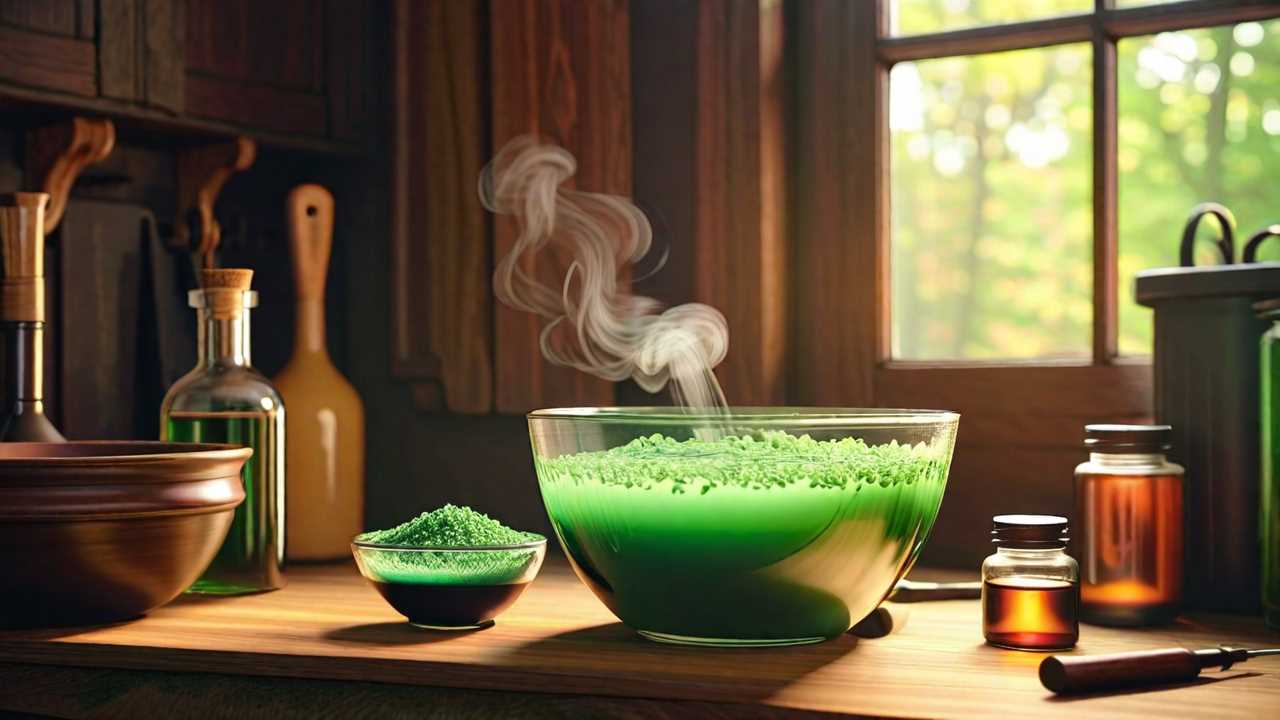
When considering how to make homemade soap, the process may seem complex at first, but with the right guidance, it can become an enjoyable and rewarding craft. As you gather your supplies and ingredients, the precise measurements and careful blending will be essential for success. From selecting the perfect oils to deciding on the ideal scent profile, each step plays an important role in creating a luxurious bar of soap. Stay tuned to discover the art of molding, curing, and storing your homemade creation for best results.
Essential Supplies and Ingredients
To begin making homemade soap, gather the essential supplies and ingredients required for the process. You'll need a digital kitchen scale to accurately measure ingredients, a heat-safe container such as a stainless steel pot for melting oils, a thermometer to monitor temperatures, protective gear like gloves and goggles to guarantee safety, a stick blender for mixing the ingredients, molds to shape the soap, and a clean workspace free from any distractions.
The key ingredients for making soap include distilled water, sodium hydroxide (lye), and a combination of oils or fats. Common oils used in soap making are coconut oil, olive oil, palm oil, and castor oil. Each oil brings different properties to the soap, such as hardness, lather, and moisturizing abilities.
It's essential to accurately measure all ingredients following a recipe to ensure the soap turns out as desired.
Choosing the Right Oils
When selecting oils for making homemade soap, consider the desired properties you want the soap to have. Different oils bring unique qualities to the soap, so choosing the right combination is essential for achieving the desired outcome.
Here are some factors to keep in mind:
- Hardness: Oils like coconut oil and palm oil contribute to a harder bar of soap.
- Lathering: If you want a soap that lathers well, consider oils such as castor oil or cocoa butter.
- Moisturizing: Oils like olive oil and shea butter are known for their moisturizing properties, making them ideal for soaps that are gentle on the skin.
Scent Selection and Blending
Consider the impact of scent selection and blending on the overall quality of your homemade soap. The scent of your soap plays an essential role in how it's perceived by users. When selecting scents, opt for essential oils over fragrance oils for a more natural product. Essential oils are derived from plants and offer various therapeutic benefits. Guarantee the scents you choose complement each other to create a harmonious blend.
Start by selecting a dominant scent, followed by secondary and tertiary scents to improve the overall aroma. Keep in mind that some scents may fade or change during the soap-making process, so choose oils that are known for their stability. Experiment with different combinations in small batches to find the perfect blend that resonates with you.
Bear in mind that some scents may trigger allergic reactions in certain individuals, so always label your products with a list of ingredients to inform users of potential allergens. By carefully selecting and blending scents, you can enrich the sensory experience of your homemade soap.
Molding, Curing, and Storage
Guarantee proper molding, curing, and storage techniques are employed to maintain the quality and longevity of your homemade soap. Follow these key steps:
- Molding:
- Use silicone molds for easy removal.
- Pack the soap mixture tightly to prevent air bubbles.
- Allow the soap to set for 24-48 hours before unmolding.
- Curing:
- Place the unmolded soap in a well-ventilated area.
- Let it cure for 4-6 weeks to harden and improve quality.
- Turn the soap bars occasionally for even curing.
- Storage:
- Store cured soap in a cool, dry place.
- Keep soap away from direct sunlight to prevent color fading.
- Use breathable packaging to avoid moisture buildup.
Frequently Asked Questions
Can I Use Food Coloring in Homemade Soap?
Yes, you can use food coloring in homemade soap. However, make sure it is skin-safe and suitable for soap making. Add it sparingly to achieve the desired hue, mixing thoroughly to prevent uneven color distribution.
How Do I Prevent Air Bubbles in My Soap?
To prevent air bubbles in your soap, make sure to mix your ingredients gently and thoroughly. Use a stick blender at a low setting and tap the mixing container on a surface to release trapped air.
Can I Use Essential Oils for Fragrance in Soap?
Wondering if essential oils work for soap fragrance? Absolutely! They add delightful scents and some even offer additional benefits. Remember, always check the recommended usage rates to achieve the perfect balance in your homemade soap.
What Should I Do if My Soap Turns Out Too Soft?
If your soap turns out too soft, consider adjusting your recipe by adding more hard oils like coconut or palm. Rebatching the soap can also help salvage it. Allow the soap to cure longer for better results.
How Can I Safely Add Exfoliants to My Soap?
To safely add exfoliants to your soap, make sure they are finely ground to prevent abrasiveness. Gradually mix exfoliants into the soap base until evenly distributed. Test small batches first to determine the right amount for desired exfoliation without causing irritation.
 SportsHollywoodLifestyleFashionHome & GardenTrendsPrivacy PolicyTerms And Conditions
SportsHollywoodLifestyleFashionHome & GardenTrendsPrivacy PolicyTerms And Conditions
